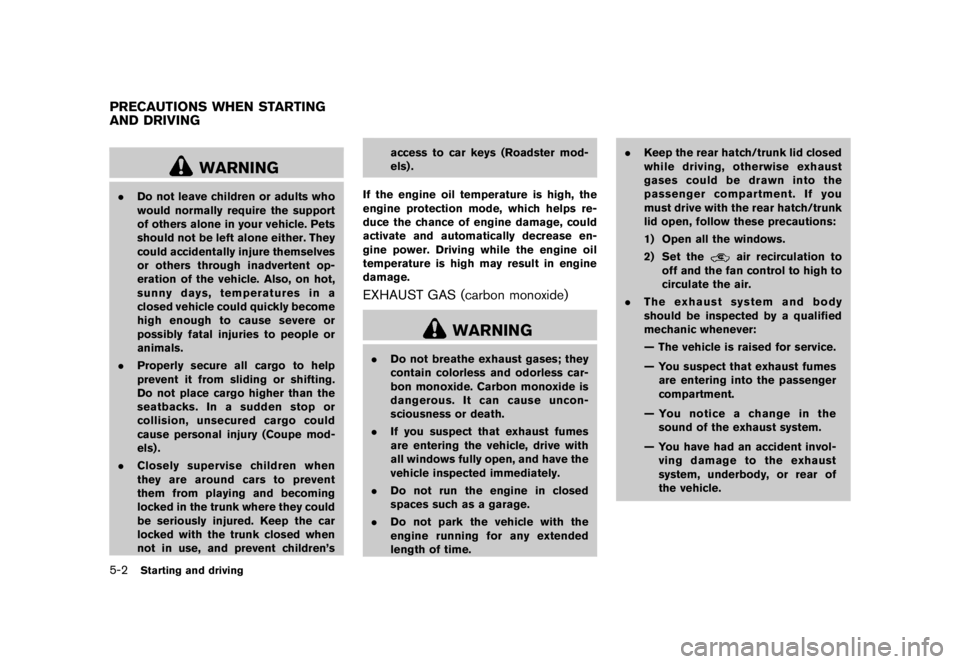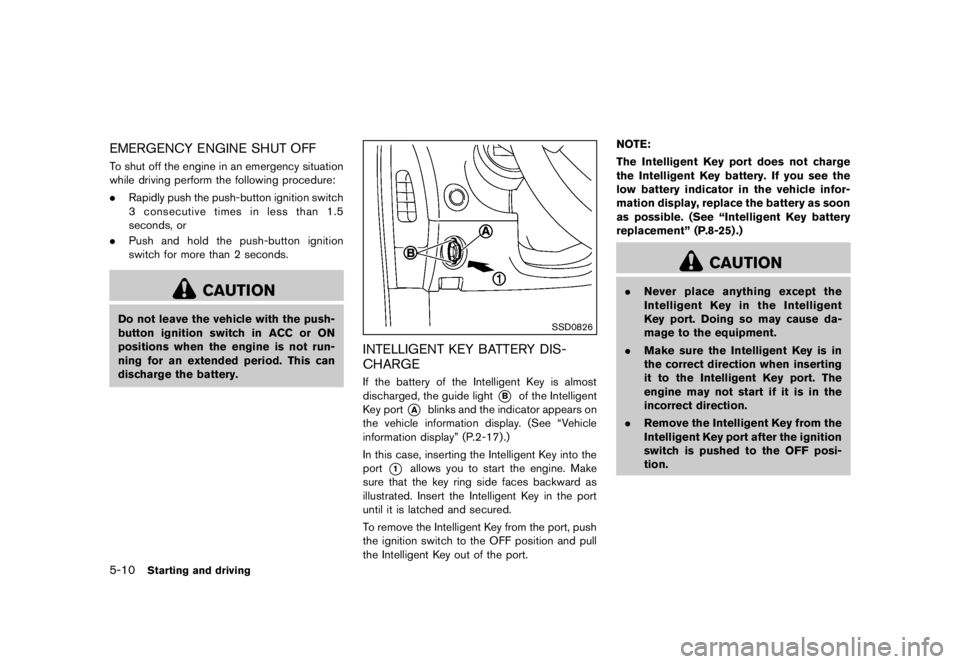2012 NISSAN 370Z ignition
[x] Cancel search: ignitionPage 226 of 1281

Rapid air pressure loss...
................................................ 5-6
Readiness for inspection/maintenance
(I/M) test ...
........................................................................ 9-24
Rear hatch ...
..................................................................... 3-16
Rear hatch opener ...
...................................................... 3-16
Rear hatch opener switch ...
......................................... 3-17
Rear parcel box ...
........................................................... 2-43
Rear window defroster switch ...
................................. 2-31
RearView monitor (models with
navigation system) ...
...................................................... 4-18
Recorders, Event data ...
............................................... 9-24
Registering your vehicle in another country ...
......... 9-11
Remote keyless entry system ...
................................... 3-13
Repairing flat tire (with emergency tire puncture
repair kit) ...
......................................................................... 6-8
Reporting safety defects ...
........................................... 9-23
Rollover ...
............................................................................ 5-6
Roof, Soft top ...
.............................................................. 3-21
S
Safety, Child seat belts ...
............................................. 1-15
Satellite radio operation ...
................................ 4-50, 4-55
Seat adjustment Front manual seat adjustment ...
.............................. 1-4
Front power seat adjustment ...
............................... 1-2
Front seats ...
................................................................ 1-2
Seat belt(s) Child safety ...
............................................................ 1-15
Infants ...
...................................................................... 1-15
Injured persons ...
..................................................... 1-11
Larger children ...
...................................................... 1-16
Precautions on seat belt usage ...
........................... 1-9
Pregnant women ...
.................................................. 1-11
Seat belt cleaning ...
................................................... 7-7
Seat belt extenders ...
.............................................. 1-14
Seat belt maintenance ...
........................................ 1-14 Seat belt warning light and chime
...
................... 2-13
Seat belts ...
.................................................................. 1-9
Seat belts with pretensioners ...
........................... 1-39
Three-point type ...
................................................... 1-11
Seat(s) Climate controlled seats ...
..................................... 2-38
Heated seats ...
......................................................... 2-37
Seats ...
.......................................................................... 1-2
Secondary rear hatch release ...
.................................. 3-18
Secondary trunk lid release ...
...................................... 3-20
Security system (NISSAN Vehicle Immobilizer
System) , Engine start ...
................................................. 2-28
Security system, Vehicle security system ...
............. 2-27
Selector lever, Shift lock release ...
............................ 5-16
Servicing air conditioner ...
............................................ 4-30
SETTING button ...
.......................................................... 4-11
Shift lock release, Transmission ...
.............................. 5-16
Shift “P” warning (Automatic
Transmission models) ...
................................................ 2-19
Shifting Automatic transmission ...
....................................... 5-12
Manual transmission ...
............................................ 5-16
Soft top Care and cleaning ...
................................................... 7-3
If the top does not open or close ...
.................... 3-28
Opening using the Intelligent Key ...
.................... 3-26
Soft top indicator light ...
............................. 2-15, 3-24
Soft top operation ...
................................................ 3-21
Spare tire ...
......................................................................... 9-9
Spark plugs ...
.................................................................. 8-19
Speedometer ...
.................................................................. 2-6
Starting Before starting the engine ...
................................. 5-11
Jump starting ...
......................................................... 6-14
Precautions when starting and driving ...
.............. 5-2
Push starting ...
......................................................... 6-16
Starting the engine ...
.............................................. 5-11 STATUS button
...
.............................................................. 4-7
Status light, Front passenger air bag ...
.................... 1-35
Steering Power steering fluid ...
............................................. 8-13
Power steering system ...
....................................... 5-25
Steering-wheel-mounted controls
for audio ...
................................................................. 4-74
Storage ...
.......................................................................... 2-41
Sun visors ...
..................................................................... 3-36
Supplemental air bag warning labels ...
..................... 1-40
Supplemental air bag warning light ...
............ 1-40, 2-13
Supplemental restraint system ...
................................. 1-28
Precautions on supplemental
restraint system ...
..................................................... 1-28
Switch Autolight switch ...
.................................................... 2-33
Fog light switch ...
.................................................... 2-35
Hazard warning flasher switch ...
.......................... 2-36
Headlight switch ...
................................................... 2-32
Ignition switch ...
....................................................... 5-12
Ignition switch manual
transmission models ...
............................................ 5-16
Power door lock switch ...
......................................... 3-5
Rear window defroster switch ...
.......................... 2-31
Turn signal switch ...
................................................ 2-35
Vehicle dynamic control (VDC) off switch ...
..... 2-39
SynchroRev Match mode (S-MODE) ...
.................... 5-17
T
Tachometer ...
..................................................................... 2-6
Temperature gauge, Engine coolant
temperature gauge ...
........................................................ 2-7
Theft (NISSAN Vehicle Immobilizer System) ,
Engine start ...
................................................................... 2-28
Three-way catalyst ...
........................................................ 5-3
Tilt steering ...
................................................................... 3-36
10-5
Page 290 of 1281

pressure telltale.
Your vehicle has also been equipped with a
TPMS malfunction indicator to indicate when the
system is not operating properly. The TPMS
malfunction indicator is combined with the low
tire pressure telltale. When the system detects a
malfunction, the telltale will flash for approxi-
mately one minute and then remain continuously
illuminated. This sequence will continue upon
subsequent vehicle start-ups as long as the
malfunction exists. When the malfunction indi-
cator is illuminated, the system may not be able
to detect or signal low tire pressure as intended.
TPMS malfunctions may occur for a variety of
reasons, including the installation of replace-
ment or alternate tires or wheels on the vehicle
that prevent the TPMS from functioning properly.
Always check the TPMS malfunction telltale
after replacing one or more tires or wheels on
your vehicle to ensure that the replacement or
alternate tires and wheels allow the TPMS to
continue to function properly.
Additional informationGUID-F08D0811-1070-4649-89CE-0F3AF1BDE3F8.The TPMS does not monitor the tire
pressure of the spare tire.
. The TPMS will activate only when the
vehicle is driven at speeds above 16 MPH
(25 km/h) . Also, this system may not detect
a sudden drop in tire pressure (for example a flat tire while driving) .
. The low tire pressure warning light does not
automatically turn off when the tire pressure
is adjusted. After the tire is inflated to the
recommended pressure, the vehicle must be
driven at speeds above 16 MPH (25 km/h)
to activate the TPMS and turn off the low tire
pressure warning light. Use a tire pressure
gauge to check the tire pressure.
. The CHECK TIRE PRESSURE warning also
appears on the vehicle information display
when the low tire pressure warning light is
illuminated and low tire pressure is detected.
The CHECK TIRE PRESSURE warning
turns off when the low tire pressure warning
light turns off.
The CHECK TIRE PRESSURE warning
appears each time the ignition switch is
placed in the ON position as long as the low
tire pressure warning light remains illumi-
nated.
The CHECK TIRE PRESSURE warning
does not appear if the low tire pressure
warning light illuminates to indicate a TPMS
malfunction.
. Tire pressure rises and falls depending on
the heat caused by the vehicle’s operation
and the outside temperature. Low outside
temperature can lower the temperature of the air inside the tire which can cause a
lower tire inflation pressure. This may cause
the low tire pressure warning light to
illuminate. If the warning light illuminates in
low ambient temperature, check the tire
pressure for all four tires.
For additional information, see “Low tire pres-
sure warning light” (P.2-12) and “Tire Pressure
Monitoring System (TPMS)” (P.6-2) .
Page 298 of 1281

.When the vehicle is stopped.
. When the ignition switch is ON.
. When the trunk is closed.
. When the selector lever or shift lever is in a
position other than the R (Reverse) position.
Page 358 of 1281

This means the system is operational.
If any of the following conditions occur, the front
air bag, side air bag, curtain air bag and
pretensioner systems need servicing:
.The supplemental air bag warning light
remains on approximately 7 seconds after
the ignition switch is pushed to the ON
position.
. The supplemental air bag warning light
flashes intermittently.
. The supplemental air bag warning light does
not come on at all.
Under these conditions, the front air bag, side air
bag, curtain air bag or pretensioner systems may
not operate properly. They must be checked and
repaired. Take your vehicle to the nearest
NISSAN dealer.
Page 485 of 1281

This means the system is operational.
If any of the following conditions occur, the front
air bag, side air bag, curtain air bag and
pretensioner systems need servicing:
.The supplemental air bag warning light
remains on approximately 7 seconds after
the ignition switch is pushed to the ON
position.
. The supplemental air bag warning light
flashes intermittently.
. The supplemental air bag warning light does
not come on at all.
Under these conditions, the front air bag, side air
bag, curtain air bag or pretensioner systems may
not operate properly. They must be checked and
repaired. Take your vehicle to the nearest
NISSAN dealer.
Page 502 of 1281

.When the vehicle is stopped.
. When the ignition switch is ON.
. When the trunk is closed.
. When the selector lever or shift lever is in a
position other than the R (Reverse) position.
Page 551 of 1281

computer.
. When the vehicle is parked near a parking
meter.
In such cases, correct the operating conditions
before using the Intelligent Key function or use
the mechanical key.
Although the life of the battery varies depending
on the operating conditions, the battery’s life is
approximately 2 years. If the battery is dis-
charged, replace it with a new one.
When the Intelligent Key battery is almost
discharged, insert the Intelligent Key into the
Intelligent Key port to start the engine. Replace
the discharged battery with a new one as soon
as possible. For more details, see “Push-button
ignition switch” (P.5-8) .
Since the Intelligent Key is continuously receiv-
ing radio waves, if the key is left near equipment
which transmits strong radio waves, such as
signals from a TV and personal computer, the
battery life may become shorter.
For information regarding replacement of a
battery, see “Intelligent Key battery replacement”
(P.8-25) .
As many as 4 Intelligent Keys can be registered
and used with one vehicle. For information about
the purchase and use of additional Intelligent
Keys, contact a NISSAN dealer.
Page 714 of 1281

pressure telltale.
Your vehicle has also been equipped with a
TPMS malfunction indicator to indicate when the
system is not operating properly. The TPMS
malfunction indicator is combined with the low
tire pressure telltale. When the system detects a
malfunction, the telltale will flash for approxi-
mately one minute and then remain continuously
illuminated. This sequence will continue upon
subsequent vehicle start-ups as long as the
malfunction exists. When the malfunction indi-
cator is illuminated, the system may not be able
to detect or signal low tire pressure as intended.
TPMS malfunctions may occur for a variety of
reasons, including the installation of replace-
ment or alternate tires or wheels on the vehicle
that prevent the TPMS from functioning properly.
Always check the TPMS malfunction telltale
after replacing one or more tires or wheels on
your vehicle to ensure that the replacement or
alternate tires and wheels allow the TPMS to
continue to function properly.
Additional informationGUID-F08D0811-1070-4649-89CE-0F3AF1BDE3F8.The TPMS does not monitor the tire
pressure of the spare tire.
. The TPMS will activate only when the
vehicle is driven at speeds above 16 MPH
(25 km/h) . Also, this system may not detect
a sudden drop in tire pressure (for example a flat tire while driving) .
. The low tire pressure warning light does not
automatically turn off when the tire pressure
is adjusted. After the tire is inflated to the
recommended pressure, the vehicle must be
driven at speeds above 16 MPH (25 km/h)
to activate the TPMS and turn off the low tire
pressure warning light. Use a tire pressure
gauge to check the tire pressure.
. The CHECK TIRE PRESSURE warning also
appears on the vehicle information display
when the low tire pressure warning light is
illuminated and low tire pressure is detected.
The CHECK TIRE PRESSURE warning
turns off when the low tire pressure warning
light turns off.
The CHECK TIRE PRESSURE warning
appears each time the ignition switch is
placed in the ON position as long as the low
tire pressure warning light remains illumi-
nated.
The CHECK TIRE PRESSURE warning
does not appear if the low tire pressure
warning light illuminates to indicate a TPMS
malfunction.
. Tire pressure rises and falls depending on
the heat caused by the vehicle’s operation
and the outside temperature. Low outside
temperature can lower the temperature of the air inside the tire which can cause a
lower tire inflation pressure. This may cause
the low tire pressure warning light to
illuminate. If the warning light illuminates in
low ambient temperature, check the tire
pressure for all four tires.
For additional information, see “Low tire pres-
sure warning light” (P.2-12) and “Tire Pressure
Monitoring System (TPMS)” (P.6-2) .